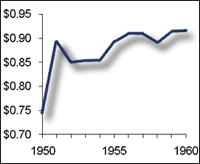


(yearly average prices based on London PM Fix)
From the end of World War II through the early 1960s, fabrication demand for silver rose sharply. The rebuilding of Europe and Japan and a worldwide movement toward electrification, housing construction and durable consumer items was responsible for this uptick. Many electrical appliances, as well as electrical generation and transmission systems, use silver, which was one of the major factors behind this extended boom in industrial silver usage. Also key was the advent of mass-market photography, which uses silver in its films and papers.
However, there was another important reason that fabricators were eagerly turning to silver during this period. The U.S. Treasury had a stockpile of silver dating from decades earlier, which it sold off in order to keep the price of silver below its “monetary value” – a number that would correspond to the increased demand and unchanging supply. In summary, the post-war period saw silver demand rise sharply, while mine production and other supplies were relatively stable. Additionally, the actual growth of the overall economy increased the need for circulating coinage. One reason for the Treasury’s sales was straightforward: if silver’s market value rose above its monetary value, $1.29 per ounce, holders of U.S. silver certificates, one form of currency in circulation at the time, could trade in these $1, $5, and $10 bills in exchange for silver bullion. Also, there would be an enormous incentive for individuals to melt down the silver coins in circulation.
Had the Treasury not been present as a seller of silver, market supplies from other sources would have been hard pressed to keep pace with the growth of fabrication demand, and the price of silver most likely would have risen sharply during the late 1950s and early 1960s.
